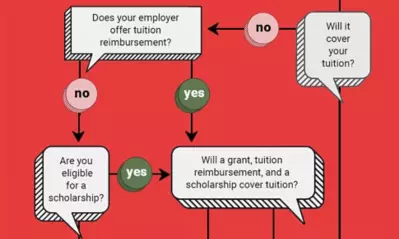How to save money for college

Written by Elizabeth Exline

Why is saving money hard?
Setting savings goals is kind of like exercise. You know you should, and you feel better when you do, but it takes commitment and focus.
So, how do you make yourself do it anyway?
Chris Conway, the director of financial wellness at University of Phoenix, has a few ideas. So do her students in Everyday Economics and Finances . Here, Conway draws on her financial prowess as well as pointers shared by her students to reveal money-saving tips in three distinct categories.
Save money on daily expenses
In life, it’s the little things that count. Hugs and kisses from your kids make your day happier, for example, and so does saving money on your electric bill. Conway and her students can’t help you with the former, but they have a few ideas on ways to impact your savings goals.
Get comfortable being a little uncomfortable
Energy prices are predicted to rise during the winter of 2022–23, which means heating your home will likely cost more than it did last year. The solution? Keep your house a little cooler than you might otherwise choose. Throw on a sweater during the day or an extra blanket at night. And if you have a programmable thermostat, use it to lower the temperature while you’re out or sleeping.
Set your water heater to 120 degrees
Some water heater manufacturers set thermostats to a default 140 degrees, but you can safely dial that down to 120 degrees and still prevent bacteria growth. Doing so will also prevent scalding, corrosion and wasted money. According to Energy.gov, you can potentially save more than $400 a year with that 20-degree adjustment.
Use less water and energy overall
This energy-efficient approach offers the twin benefits of saving money and conserving resources. It’s also relatively easy to do.
For example, turn off lights when you leave a room, unplug appliances when you’re not using them (that toaster is still charging when it’s plugged in) and switch to LED lightbulbs — they use 75% less energy and last 25% longer than incandescent lighting.
As for water, use a dishwasher instead of handwashing your plates and utensils. Dishwashers manufactured after 2013 use between 3.5 and 5 gallons of water per load whereas handwashing the same load of dishes can use between 9 and 27 gallons.
Beyond that, be mindful when you run the tap. “I was in South Africa when they were expecting to run out of water and had severe water restrictions,” Conway says. “I learned it is possible to take a shower with less than two minutes of water and that turning off the water while washing dishes and brushing teeth can make a difference.”
Need help with your utility bills? Find out what assistance is available through the Low Income Home Energy Assistance Program .
Save money on food
Food prices are eating up an increasing portion of family budgets thanks to rising prices. In fact, the Economic Research Service for the U.S. Department of Agriculture reported an estimated increase of 9.5% to 10.5% for all food prices . And if you think eating at home will help you avoid the brunt of that increase, think again: Food-at-home prices were predicted to rise between 11% and 12% in 2022.
So, how do you eat well without breaking the bank? Plan ahead.
Meal Planning 101
Planning dinner one week at a time offers some serious advantages. You can pick recipes that use the same ingredients, so you throw away less food. You can also eat more healthfully and avoid picking up fast food for lack of a better option.
Conway notes plenty of apps are available to help you plan meals. (You can also explore new recipes online, or just flip through some favorite recipe books.)
Shop smart
Once you have your list, it’s time to search out the best deals. Coupons and reward sites, including grocery store apps, offer deals as do loyalty programs at stores. (Join more than one to find the best deals each week!)
Conway says it can pay off to go old school, such as checking grocery-store circulars in the mail or looking for coupons in the Sunday paper.
Also, consider purchasing generic brands. Swapping out brand-name cereals, milk and other packaged foods for generic options can add up to significant savings.
If you find it hard to resist impulse purchases at the store, do your shopping online. After the pandemic, many stores offer contactless pick-up options that let you grocery shop without setting foot inside the store.
Eat less meat
Meat can be expensive, especially when you have a taste for steak and seafood. Try planning two or three vegetarian meals each week.
“Breakfast for dinner can be less expensive and is less dependent on meat,” Conway adds. “A bowl of cereal can be like comfort food too!”
When you do eat meat, see if you can make it last for a few meals. One roasted chicken might be dinner one night and lunch the next day, for example.
Bulk buying is another way to save, especially for pantry staples like flour, rice, beans and pasta. Just make sure you use what you buy. “It’s not savings unless you’ll use it before it expires,” Conway says.
Save on entertainment
Are the best things in life free? They are if you know where to look! Whether it’s gifts during the holidays or weekend entertainment, having fun doesn’t have to exhaust your bank account.
Use rewards for birthday and holiday gifts
If you shop at a department store that offers rewards, you can do double duty by shopping there throughout the year for what you need and then using the rewards to purchase gifts for others.
Of course, trimming that gift list makes shopping even more affordable. “Talk to friends and family about gifts that don’t cost money,” Conway suggests. “Can you make something for them? Repair or work on something for their house? Help with gardening? Babysit or pet sit?”
You can also suggest skipping gifts altogether. “My family did this about 10 years ago when we chose to buy gifts only for the kids [for Christmas],” Conway says. “We haven’t looked back, and it makes the holidays less stressful!”
Find coupons for activities
You don’t have to sit home all weekend if you’re looking for free or cheap entertainment. In addition to simply searching “Free things to do this weekend,” you can check online coupon sites for reduced fares to area and special attractions. Museums offer reduced rates or complimentary admission on certain days.
Seek out better rates or subscriptions
Go through your credit card bill item by item to make sure your monthly subscriptions are truly necessary. It’s easy to forget you’ve signed up for a free trial of a television channel and then end up paying for it for months after the trial ends.
Some people recommend canceling cable in favor of a subscription service. If you go that route, just make sure you don’t end up paying more for multiple subscriptions than you would for cable. And, if you really like cable, try calling your provider every year or two to see if a lower rate is available.
“They might say no, but it’s worth asking, since they’ll often find a deal,” Conway says.
5 others way to save
Once you get into the savings mindset, you might find it gets easier to apply it to other areas of your life and long-term goals. With this in mind, Conway offers the following tips:
1. Automate your savings account: Set up a monthly transfer of cash from your checking account to a savings account. Keeping the accounts separate makes it easier to leave the savings account alone where it can grow.
2. Set up an emergency fund: Separate from a savings account, an emergency fund is designed to see you through unexpected financial emergencies, such as medical expenses, car repairs and other big-ticket, rarely-planned-for bills. How much, how often and where you save is up to you, but it’s generally a good idea to have three to six months’ worth of living expenses
set aside in case of a job loss. Even a smaller amount can provide some security.
3. Find your community of penny-pinchers: Thrift is in style, Conway says, “and lots of people are willing to share what has been successful for them.” Check out social media for tips and groups.
4. Get familiar with coupon sites and apps: Explore coupon sites and apps — including browser extensions — that cull the best discounts and deals. Before you buy, try conducting an online search by pairing the store name with “coupon code” to see if any coupons are out there. You can also visit rebate sites for necessary purchases like appliances and search for price-matching apps to find the lowest price on items large and small.
5. Consolidate debt: If you have multiple sources of debt, it may be beneficial to combine them into one payment plan . Depending on what kind of debt you have, a debt-consolidation loan from a bank or a balance transfer of credit-card debt to one credit card can help make it easier to pay down. However, these options are not without risks, including interest rates that rise sharply after a certain time period and hidden fees. The Consumer Financial Protection Bureau
recommends consulting a nonprofit credit counselor before making a move.
Just like finding an exercise regimen you like, finding your savings style can be a process. The rewards, however, justify the effort.
This article is not intended to serve as financial advice. All financial decisions, including investments, should be made carefully and potentially with the guidance of a professional financial advisor.

ABOUT THE AUTHOR
Elizabeth Exline has been telling stories ever since she won a writing contest in third grade. She's covered design and architecture, travel, lifestyle content and a host of other topics for national, regional, local and brand publications. Additionally, she's worked in content development for Marriott International and manuscript development for a variety of authors.
This article has been vetted by University of Phoenix's editorial advisory committee.
Read more about our editorial process.
Read more articles like this:


